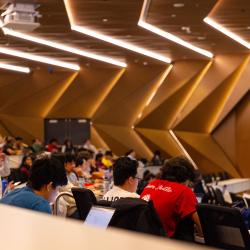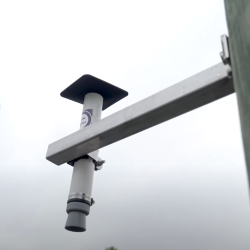A Summer School Unlike Any Other
Q&A with ESSIC’s Santiago Gassó, who spent a month at sea teaching remote sensing to graduate students from around the world
This summer, Santiago Gassó, an associate research scientist at the University of Maryland’s Earth System Science Interdisciplinary Center, joined a teaching cruise aboard the German icebreaker Polarstern. Dubbed the “South-North Atlantic Training Transect (SoNoAT) Floating Summer School,” the cruise departed from Port Stanley in the Falkland Islands on June 2, 2019, and concluded in the Polarstern’s home port of Bremerhaven, Germany, on June 29, 2019.
Gassó joined 23 students and 12 other instructors on the four-week cruise, which focused on teaching graduate students the tools and techniques necessary for oceanographic observations. The communications team in UMD’s College of Computer, Mathematical, and Natural Sciences caught up with Gassó to talk about his experience aboard the Polarstern. Read on for his thoughts and reflections.
This was not a typical research cruise. What was the goal?
The Alfred Wegener Institute (AWI), which is similar to the Woods Hole Oceanographic Institution or the Scripps Institution of Oceanography here in the U.S., owns and operates the Polarstern. It’s an icebreaker used for polar oceanographic research and to resupply Germany’s polar research stations. At the conclusion of the Antarctic research season, AWI must return the vessel to its home port in Germany. Instead of just sailing the boat north, AWI takes advantage of the opportunity to provide training for students.
The goal was to train these aspiring oceanographers and expose them to the experience of doing actual oceanography research, with opportunities to practice using the tools they might encounter in their future professional lives. With open-source data, an oceanographer can technically spend an entire career studying the ocean without ever going to sea. This experience is meant to change that.
The training was organized by the Ocean Training Partnership, which received more than 800 applications from students all over the world. From that pool, they selected 25 finalists and 23 joined the cruise. I was invited to teach about satellite remote sensing. Of the 13 instructors on board, I was the only atmospheric scientist in the group—everyone else focused on aspects of oceanography.
I gained an appreciation for what it takes to organize a cruise like this. Because it falls outside the core research mission of AWI and the Polarstern, this trip was only possible thanks to the leaders of the Ocean Training Partnership. They provided funding for airplane travel and hotel stays, while coordinating all of the logistics—including all the visas needed to enable travel to and from many different countries. It must have been a daunting task, but everything happened on time and safely.
What is it like to be at sea for a full month?
I’ve been to sea before, as I used to pilot sailboats. But those boats were nothing like a big ship with engines—and certainly nothing close to the size of the Polarstern. With 45 crew members and another 36 scientists and students aboard, it felt like a fairly big vessel. It has a helipad with two helicopters and a remotely operated submarine. It’s a marvelous piece of German engineering. I was told that it is an old-fashioned icebreaker of a type that is no longer built. Although we were not traveling through sea ice, it was very cool to see it up close.
The accommodations may not be glamorous but they were very comfortable. It felt like a hotel, with all sorts of amenities. Up on deck, there were endless views at any time of day. Once we were underway, the closest piece of land was more than 100 miles away. With nothing but air above, three miles of water below, and water all around as far as the eye can see, it can feel a little isolating at times.
The students were very emotional when the trip ended. It was clearly a bonding experience for them and they were all sad to leave their new friends. They came from all over the world, including Madagascar, Brazil, Columbia, Israel, Spain, Germany and India. Two-thirds of the students were women. It was a very mixed environment by design.
How did you get involved and what was your role?
The Ocean Training Partnership has a roster of instructors who get invited on cruises. But for my topic, satellite remote sensing, they were short by one instructor. So they tapped their network to look for recommendations and an old colleague mentioned my name. This is a researcher who I hadn’t talked to in 10 years, but we reconnected via Twitter and started communicating again about two years ago. It was very flattering that they thought I would be a good fit for this cruise. Teaching was a little intimidating at first, but it was very rewarding for me personally.
 Within remote sensing, my focus is on detecting pollution, smoke and dust. My lectures focused on the importance of these measurements for understanding the Earth system. I also taught the students how to model a dust storm. In the north Atlantic at this time of year, there are plenty of dust storms to keep students and researchers busy. I brought several portable NASA instruments with me to measure dust and other background levels of pollution. When you point these instruments at the sun, they detect any decrease in sunlight that results from a dust cloud in the air, providing a measurement of dust concentration. This is an essential parameter for dust models and air quality forecasts.
Within remote sensing, my focus is on detecting pollution, smoke and dust. My lectures focused on the importance of these measurements for understanding the Earth system. I also taught the students how to model a dust storm. In the north Atlantic at this time of year, there are plenty of dust storms to keep students and researchers busy. I brought several portable NASA instruments with me to measure dust and other background levels of pollution. When you point these instruments at the sun, they detect any decrease in sunlight that results from a dust cloud in the air, providing a measurement of dust concentration. This is an essential parameter for dust models and air quality forecasts.
I also exposed the students to a model that calculates the dispersion of a dust cloud by wind. The National Oceanic and Atmospheric Administration (NOAA) created the model, called Hybrid Single Particle Lagrangian Integrated Trajectory (HYSPLIT). The students found the program appealing because it has a user-friendly interface and is freely available for anyone to use. The group was divided into five subgroups, so I would teach the same module every few days. The goal wasn’t necessarily to master the techniques, but rather to give them some flavor of what they can do and how the tools work.
What did you learn from the experience?
It was a transforming experience. On a personal level, I knew it would test my social skills. Among the roughly 80 people on the ship, I only knew one—and the last time I saw him was more than 10 years ago! On a professional level, it was extremely fulfilling to teach students and interact with scientists outside my core discipline. It was also very rewarding to see a dust storm—which I usually observe remotely from space—up close and in person. The experience reinforced my love for the subject and gave me more ideas to improve observations of these phenomena from space.
If I was asked to participate again, I would definitely say yes! I would know better how to work around some of the unexpected challenges and changes in plan. Weather is always a factor and people can get seasick, so there were frequent last-minute changes to the daily schedule. That was a little unnerving to me at first, but we always managed to make it work. I’m ready for a repeat trip!
###
Media Relations Contact: Matthew Wright, 301-405-9267, mewright@umd.edu
University of Maryland
College of Computer, Mathematical, and Natural Sciences
2300 Symons Hall
College Park, MD 20742
www.cmns.umd.edu
@UMDscience
About the College of Computer, Mathematical, and Natural Sciences
The College of Computer, Mathematical, and Natural Sciences at the University of Maryland educates more than 9,000 future scientific leaders in its undergraduate and graduate programs each year. The college's 10 departments and more than a dozen interdisciplinary research centers foster scientific discovery with annual sponsored research funding exceeding $175 million.







